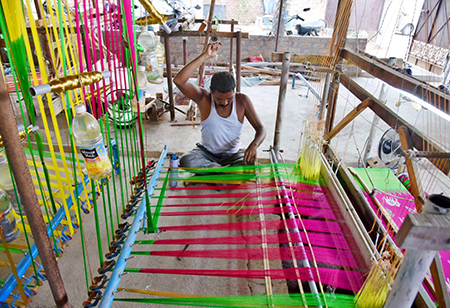Handloom culture has seen its commence from the time when leaders like Gandhi, Bal Gangadhar Tilak, Lala Lajpat Rai and other prominent figures led India. Repeatedly, people were insisted to boycott swadeshi items and were told to avail only desi goods. And Khadi during that time had begun entering living rooms, marking a juncture where each and every Indian endeared Khadi, so much so that it had created a patriotic turbulence amid the independence struggle. Thus, to label the historic event, it was decided in 2015, by Prime Minister Narendra Modi that August 7 would be observed as National Handloom Day. Even today a white Khadi kurta and a pair of blue denims can never go wrong, be it any occasion on a regular, gloomy day!
Post independence, India's handloom sector has seen a remarkable growth, both in the manual weaving and natural, organic processes of creating textiles. The wide variety of fabrics that our country holds today is as diverse as our culture, creed and population.
Each state in India has its own identification of weave, from pashminas of Kashmir to captivating cottons of Kerela, each one, when draped around, looks better with age.
Presently, synthetic materials are ruling the universal markets,
with handloom industries disappearing into the air and are playing mere background roles in the central story of power loom and well-funded mills.
Yet, considering the multi-ethnic fashion parade, it can be said that pricey brands like Raw Mango, Good Earth, Jaypore, Fabindia etc. are working towards redefining these fabrics, making it gain its lost value.
But amid the layers of the fabrics, the saga of the textile artisans remains suppressed. Their contribution deserves to be narrated. Hence, on August 7, 2019, reputed designers like Ritu Kumar, Madhu Jain, David Abraham and several other eminent personalities, held a symposium at Crafts Museum, to discuss the working conditions of weavers across India. And they arrived at the conclusion that a craftsperson is the custodian of the handloom heritage and should be provided with enough employment opportunities from government, so that they take pride in what they do.
One of the distinct challenges that seem to persist in this industry is the evident apathy of the youth to take up ancient crafts, as they recognize this piece of work to be very old school. Moreover, in this career-oriented world, if analyzed from a practical perspective, youngsters emphasize on the fact that it would hardly fetch them any desirable income. The menace therefore lies in the existing generation, their ignorance towards learning this craft.
-
Further, Mrunal Thakur, a renowned actress in Bollywood quoted "The objective of the National Handloom Day is to generate awareness about the importance of the handloom industry to the socio economic development of the country."
From Charkha to powerlooms, India has experienced a rapid industrial revolution; time has come when people should acknowledge the highly skilled original artists, their creation and devotion to this celebrated arena today.
 Magazine
Magazine
